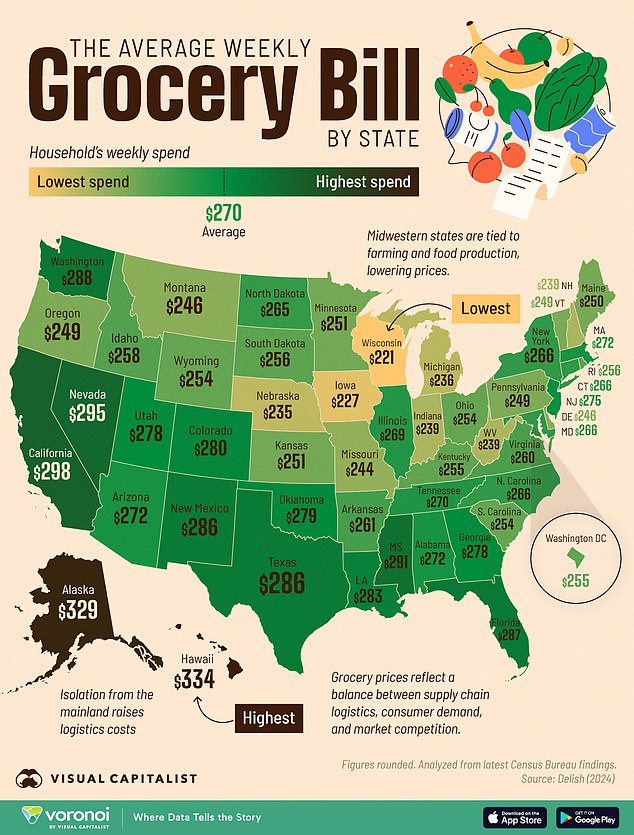The biggest issue in election exit polls was the economy, and now a map exposes the burden inflation has placed on families across the country.
Visual Capitalist, an online publication that produces data-driven content, used data from the Census Bureau to map the average amount households spend on groceries for the week in each state.
On average, Americans pay $270 per week on groceries, which amounts to $1,080 per month.
According to data from the Bureau of Labor Statistics, grocery prices have increased 20 percent since August 2020.
This is the highest inflation the US has seen since the 1970s.
According to the USDA, the COVID-19 pandemic, the conflict in Ukraine and other economic inflationary pressures, such as high energy costs, have contributed to food price increases.
States where people pay the most for groceries include Hawaii, Alaska and California. In these states, households spend an average of between $298 and $334 during their weekly visit to the market.
Even those with the lowest weekly grocery bills – Wisconsin, Iowa and Nebraska – still spend more than $200 per week, with the average cost ranging from $221 to $235.
Visual Capitalist, an online publication that produces data-driven content, used data from the Census Bureau to map the average amount spent on groceries for a week in each state
Shipping is the main reason grocery bills are skyrocketing in Alaska and Hawaii, two non-mainland states.
That’s because states don’t produce enough food locally to offset import costs Visually capitalist.
On average, Alaska households spend $334 per week at the grocery store, and Hawaiians spend $329 per week.
However, Alaska residents do receive a reduction in taxes. The Last Frontier has no statewide sales tax, and individual income and inheritances are not taxed either.
California follows closely behind, with residents of the Golden State spending about $298 for a week’s worth of groceries.
There are also some surprising states at the top of the list.
Despite the fact that the cost of living in Mississippi, New Mexico and Arizona is relatively low, high food prices earned these states spots in the top half of the rankings.
On average, households in Mississippi spend $291 per week on groceries, those in New Mexico spend $286, and those in Arizona spend $272.
The lowest grocery bills in the country are primarily in the Midwest.

On average, Americans pay $270 per week on groceries. But prices are even higher in states like Alaska, Hawaii and California
Wisconsin comes in at the very end of the list with an average weekly grocery cost of $221. This is followed by Iowa, where households spend about $227 per week at the market.
The third cheapest was Nebraska, with a weekly cost of $235.
What these states – and many others in the Midwest – have in common are local economies tied to agriculture and food production, which keep food prices low because they rely less on imported goods.
Today, the average American spends a whopping $12,960 per year on groceries.
Those annual costs have more than doubled over the past 25 years. In 2000, the average American spent about $5,158 per year at the grocery store.
Since 2020, inflation has been driven by a number of different factors.
When the COVID-19 pandemic hit that spring, U.S. consumers began stocking up on groceries in preparation for lockdowns.
Meanwhile, operations at meatpacking plants and shipping companies slowed, mainly as workers fell ill.
This caused food prices to skyrocket as demand for goods increased and supply faltered.
In 2022, Russia’s invasion of Ukraine disrupted the global food supply chain. In addition, the prices of goods such as eggs, poultry, oranges and chocolate rose due to the bird flu outbreak, floods and droughts in the US.

